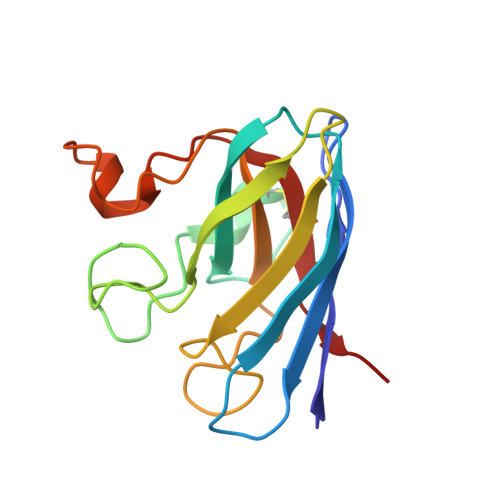A Phosphomimetic Mutation Stabilizes SOD1 and Rescues Cell Viability in the Context of an ALS-Associated Mutation.
Fay, J.M., Zhu, C., Proctor, E.A., Tao, Y., Cui, W., Ke, H., Dokholyan, N.V.(2016) Structure 24: 1898-1906
- PubMed: 27667694
- DOI: https://doi.org/10.1016/j.str.2016.08.011
- Primary Citation of Related Structures:
5K02 - PubMed Abstract:
The majority of amyotrophic lateral sclerosis (ALS)-related mutations in the enzyme Cu,Zn superoxide dismutase (SOD1), as well as a post-translational modification, glutathionylation, destabilize the protein and lead to a misfolded oligomer that is toxic to motor neurons. The biophysical role of another physiological SOD1 modification, T2-phosphorylation, has remained a mystery. Here, we find that a phosphomimetic mutation, T2D, thermodynamically stabilizes SOD1 even in the context of a strongly SOD1-destabilizing mutation, A4V, one of the most prevalent and aggressive ALS-associated mutations in North America. This stabilization protects against formation of toxic SOD oligomers and positively impacts motor neuron survival in cellular assays. We solve the crystal structure of T2D-SOD1 and explain its stabilization effect using discrete molecular dynamics (DMD) simulations. These findings imply that T2-phosphorylation may be a plausible innate cellular protection response against SOD1-induced cytotoxicity, and stabilizing the SOD1 native conformation might offer us viable pharmaceutical strategies against currently incurable ALS.
- Department of Biochemistry and Biophysics, University of North Carolina, Chapel Hill, NC 27599, USA; Program in Molecular and Cellular Biophysics, University of North Carolina, Chapel Hill, NC 27599, USA.
Organizational Affiliation:


















